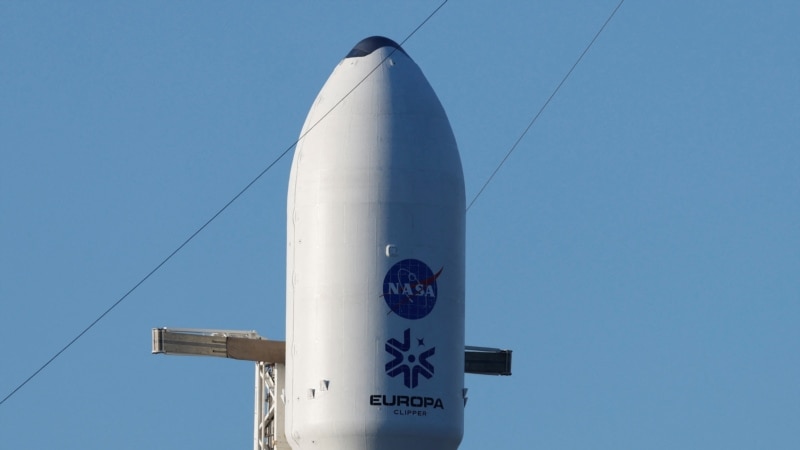A probe from the United States National Aeronautics and Space Administration (NASA) plans to begin this Monday a historic trip to Europa, Jupiter’s moon, with the aim of exploring its underground ocean and searching for possible signs of life. .
This mission, called Europa Clipper, is the largest probe developed by NASA for this type of planetary voyages and will mark the first detailed approach to this icy moon, a destination that has captured the attention of scientists for decades.
The search for life
Europa has been identified by NASA as one of the most promising places to search for extraterrestrial life in our solar system. Beneath its icy surface, it is estimated that there is a vast ocean of liquid water, making this moon an ideal candidate for exploring habitable environments outside of Earth.
“Europe is one of the most promising places for the search for life beyond Earth,” commented Gina DiBraccio, spokesperson for this NASA mission, during a press conference to which the agency had access. Voice of America.
The Europa Clipper mission, the official stressed, has as its main objective “to determine if there are places under Europa’s ice sheet that could harbor life” and will address three big questions: What is the nature of the ice sheet and the ocean below? What can we discover about its chemical and geological composition?
These answers, once obtained, “will help the scientific community better understand the astrobiological possibilities of this type of ocean worlds beyond our planet.”
When will takeoff be?
The launch of the probe is scheduled to take place this Monday, October 14, from Cape Canaveral, Florida, aboard a SpaceX Falcon Heavy rocket. Takeoff is expected to take place after 12:06 pm (local time). Europa Clipper will arrive at its destination in April 2030, and during its mission, it will perform close flybys of the moon Europa at altitudes as low as 25 kilometers above the surface.
Curt Niebur, scientist in charge of the mission, highlighted the importance of the project: “It is an opportunity for us to explore not a world that could have been habitable billions of years ago,” referring to Mars, “but one that could be habitable.” right now.”
The largest probe on a planetary mission
Europa Clipper will be the largest spacecraft NASA has ever developed for a planetary mission. With a height of approximately five meters and a span of more than 30 meters with its solar panels deployed, this probe is an engineering marvel. Its enormous size is due, in part, to the need to collect enough sunlight to generate energy, since the Jupiter system is five times farther from the Sun than Earth.
The technical challenges have been significant. In May, engineers discovered that some of the spacecraft’s components might not withstand Jupiter’s highly radioactive environment. However, the team successfully completed the necessary testing and gained approval in September to proceed with the launch. “There has never been a more difficult year than this to get Europa Clipper to the finish line,” Niebur said, reflecting the complexity of the mission.
Jupiter’s radiation
One of the biggest difficulties Europa Clipper will face is the extreme radiation emanating from Jupiter’s magnetic field. To protect its electronic systems, NASA has equipped the ship with a special titanium and aluminum vault. This shield, designed to resist radiation, was first used successfully on the Juno mission and will help reduce degradation of the spacecraft’s vital components.
The $5.2 billion mission represents a monumental effort in deep space exploration, and expectations are high. “The one thing we never doubted was that this would be worth it,” Niebur emphasized. “It’s an opportunity to do the first exploration of this new type of world that we have discovered very recently, called an ocean world, which is completely covered in an ocean of liquid water.”
Advanced technology for a unique mission
The Europa Clipper mission is equipped with state-of-the-art instruments to make detailed measurements. These include cameras and spectrometers capable of producing high-resolution images and maps of the composition of the surface of this star. Additionally, an ice-penetrating radar will search for signs of groundwater, while a magnetometer and gravity sensors will investigate features of the moon’s hidden ocean and interior.
The space project will also feature a thermal instrument to identify areas of warmer ice and potential water eruptions, providing crucial information about the moon’s recent geological activity. This data will help scientists understand whether the moon Europa harbors the conditions necessary to support life.
Connect with the Voice of America! Subscribe to our channels YouTube, WhatsApp and to the newsletter. Turn on notifications and follow us on Facebook, x and instagram.





![[Img #74676]](https://thelatestnews.world/wp-content/uploads/2024/12/Laser-artificial-neuron-150x150.jpg)










Add Comment